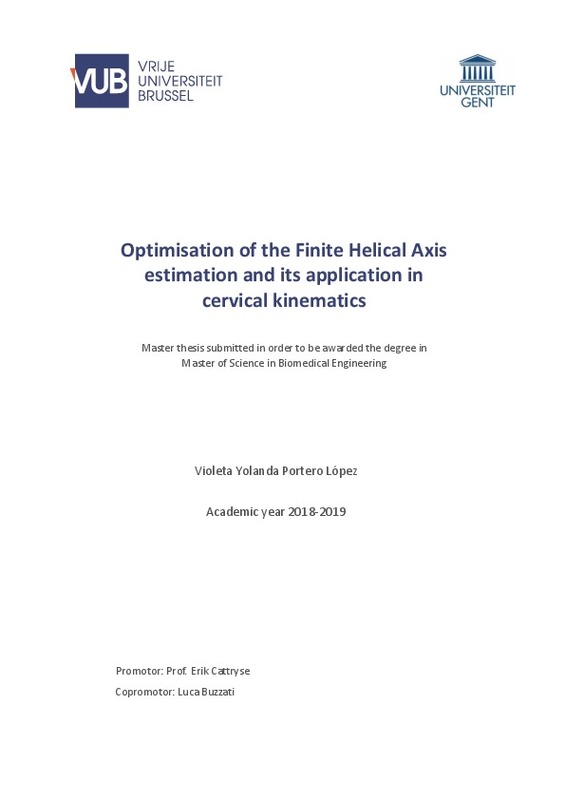JavaScript is disabled for your browser. Some features of this site may not work without it.
Buscar en RiuNet
Listar
Mi cuenta
Estadísticas
Ayuda RiuNet
Admin. UPV
Optimisation of the Finite Helical Axis estimation and its application in cervical kinematics
Mostrar el registro sencillo del ítem
Ficheros en el ítem
| dc.contributor.advisor | Vilariño Feltrer, Guillermo
|
es_ES |
| dc.contributor.author | Portero López, Violeta Yolanda
|
es_ES |
| dc.date.accessioned | 2020-05-19T06:45:46Z | |
| dc.date.available | 2020-05-19T06:45:46Z | |
| dc.date.created | 2019-09-30 | |
| dc.date.issued | 2020-05-19 | es_ES |
| dc.identifier.uri | http://hdl.handle.net/10251/143656 | |
| dc.description.abstract | [ES] Optimización del cálculo mediante la comparación de diferentes metodologías y fórmulas, definición de parámetros óptimos para la recopilación de datos durante el registro del movimiento para minimizar el error en el cálculo de la posición y la orientación del Eje Finito de Rotación | es_ES |
| dc.description.abstract | [EN] Although 6 DOF approach to analysis human movement is widely used among clinicians, it introduces problems in the reliability of the results due to the chosen reference dependence. The FHA approach solves this dependence problem since the parameters that describe its variability do not depends on the position and orientation in space relative to the chosen reference. However, it struggles with calculation error owing to the methodology used to obtain it. A rotating object simulation was performed in order to optimize the FHA estimation and find the algorithm with the least error prone. Single Value Decomposition was chosen as the most consistent method for FHA calculation after evaluating the error at different displacements. A head movement simulation performed in MATLAB was used to evaluate the effect of angle interval and adding noise on FHA error. The results of the simulation show proportional inversely between angle interval and FHA error, and a greater influence of orientation noise than position noise on FHA error. The optimisation of FHA estimations makes the FHA approach a method with less error prone which analyses with greater reliability human movement through the parameters that describe its dispersion. | es_ES |
| dc.language | Inglés | es_ES |
| dc.publisher | Universitat Politècnica de València | es_ES |
| dc.rights | Reserva de todos los derechos | es_ES |
| dc.subject | Eje | es_ES |
| dc.subject | Rotación | es_ES |
| dc.subject | Cinemática | es_ES |
| dc.subject | Biomecánica | es_ES |
| dc.subject | Optimización | es_ES |
| dc.subject | Motion | es_ES |
| dc.subject | Finite Helical Axis | es_ES |
| dc.subject | Cervical Movement | es_ES |
| dc.subject | Rotation motion | es_ES |
| dc.subject | Kinematics | es_ES |
| dc.subject | Error prone optimization | es_ES |
| dc.subject.classification | MAQUINAS Y MOTORES TERMICOS | es_ES |
| dc.subject.other | Máster Universitario en Ingeniería Biomédica-Màster Universitari en Enginyeria Biomèdica | es_ES |
| dc.title | Optimisation of the Finite Helical Axis estimation and its application in cervical kinematics | es_ES |
| dc.title.alternative | Optimización de la estimación del Eje Finito de Rotación y su aplicación en cinemática cervical | es_ES |
| dc.type | Tesis de máster | es_ES |
| dc.rights.accessRights | Abierto | es_ES |
| dc.contributor.affiliation | Universitat Politècnica de València. Departamento de Termodinámica Aplicada - Departament de Termodinàmica Aplicada | es_ES |
| dc.contributor.affiliation | Universitat Politècnica de València. Escuela Técnica Superior de Ingenieros Industriales - Escola Tècnica Superior d'Enginyers Industrials | es_ES |
| dc.description.bibliographicCitation | Portero López, VY. (2019). Optimisation of the Finite Helical Axis estimation and its application in cervical kinematics. http://hdl.handle.net/10251/143656 | es_ES |
| dc.description.accrualMethod | TFGM | es_ES |
| dc.relation.pasarela | TFGM\113751 | es_ES |
Este ítem aparece en la(s) siguiente(s) colección(ones)
-
ETSII - Trabajos académicos [10404]
Escuela Técnica Superior de Ingenieros Industriales






